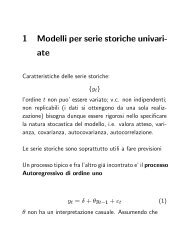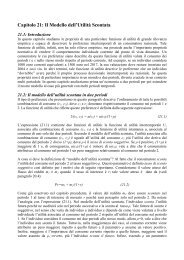algebra lineare tracce d'esame - Dipartimento di Scienze Economiche
algebra lineare tracce d'esame - Dipartimento di Scienze Economiche
algebra lineare tracce d'esame - Dipartimento di Scienze Economiche
Create successful ePaper yourself
Turn your PDF publications into a flip-book with our unique Google optimized e-Paper software.
n. 1 - Dopo aver dato la definizione <strong>di</strong> trasformazione <strong>lineare</strong> tra due spazi vettoriali, <strong>di</strong>re se sono trasformazioni<br />
lineari da R 3 in R 2 le funzioni che associano ad ogni vettore x = (x1, x2, x3) <strong>di</strong> R 3 il vettore y = (y1, y2) ∈ R 2<br />
tale che<br />
y1 = x1 − 3x2 − 2x3<br />
y2 = 2x1 − 4x2 + 3x3<br />
y1 = x1 − 3x2 − 2x3<br />
y2 = x1 − 4x2 + 3x3 − 2,<br />
<br />
y1 = x1 − x2 − 2x3<br />
.<br />
y2 = x1x2 + x3<br />
Se L é una trasformazione <strong>lineare</strong> verificare che il nucleo <strong>di</strong> L é un sottospazio vettoriale <strong>di</strong> R n .<br />
n. 2 - Dati i vettori u1 = (1, 1, −1, 0) , u2 = (−1, 3, 0, 2) e u3 = (2, 1, 3, 3),<br />
(1) verificare se tali vettori sono linearmente <strong>di</strong>pendenti o in<strong>di</strong>pendenti;<br />
(2) trovare lo spazio U generato da tali vettori e il suo complemento ortogonale, precisando la <strong>di</strong>mensione <strong>di</strong><br />
U e <strong>di</strong> U ⊥ ed in<strong>di</strong>cando una base <strong>di</strong> tali sottospazi;<br />
(3) trovare il nucleo e l’immagine della trasformazione <strong>lineare</strong> associata alla matrice A avente per righe tali<br />
vettori, e il nucleo e l’immagine della trasformazione <strong>lineare</strong> associata alla trasposta <strong>di</strong> A.<br />
(4) calcolare il determinante della matrice avente per colonne i vettori u1, u2, u3 ed (1, −2, 3, 5),<br />
(5) <strong>di</strong>re se il vettore y = (1, −2, 3, 5) T appartiene allo spazio immagine della trasformazione <strong>lineare</strong> associata<br />
ad L A T . In caso affermativo, risolvere il sistema <strong>lineare</strong> A T x = y.<br />
Ripetere l’esercizio per i vettori u1 = (1, 1, 0, −1) T , u2 = (−1, 0, 2, 2) T , u3 = (0, 1, 3, −2) T ed y = (2, 1, −3, 0) T .<br />
n. 3 - Date le matrici<br />
⎛ ⎞<br />
2 1 1<br />
⎛<br />
⎞ ⎛<br />
⎞<br />
1 −1 0 1<br />
−2 1 0 1<br />
⎜ 1 0 1 ⎟<br />
A = ⎝ ⎠ , B = ⎝ 2 0 1 0 ⎠ ⎜ α 1 0 1 ⎟<br />
, C = ⎝<br />
⎠ ,<br />
1 1 0<br />
0 −1 2 1<br />
1 −1 2 −2<br />
0 −1 1<br />
2 α −4 0<br />
a) trovare la loro caratteristica,<br />
b) trovare la <strong>di</strong>mensione del nucleo e dell’immagine della trasformazione <strong>lineare</strong> associata a tali matrici,<br />
c) <strong>di</strong>re se tale trasformazione <strong>lineare</strong> é iniettiva, suriettiva, bigettiva,<br />
d) trovare il nucleo e l’immagine <strong>di</strong> L , e il complemento ortogonale a tali sottospazi, in<strong>di</strong>candone esplicitamente<br />
una base.<br />
n. 4 - Date le matrici<br />
⎛<br />
h<br />
A = ⎝ 1<br />
1<br />
0<br />
⎞<br />
2 − h<br />
−1 ⎠ ,<br />
⎛<br />
B = ⎝<br />
1<br />
2<br />
2<br />
5<br />
⎞<br />
h<br />
1 ⎠ ,<br />
2 1 h<br />
h − 1 −1 1<br />
a) <strong>di</strong>re per quale valore del parametro h le righe <strong>di</strong> A sono linearmente <strong>di</strong>pendenti o in<strong>di</strong>pendenti,<br />
b) trovare il rango <strong>di</strong> A al variare del parametro h,<br />
c) <strong>di</strong>re per quale valore del parametro h il sistema <strong>lineare</strong> nonomogeneo Ax = y, con y = (1, −1, 0), é<br />
determinato, indeterminato o incompatibile, e trovare le eventuali soluzioni del sistema;<br />
d) scrivere le equazioni della trasformazione <strong>lineare</strong> LA associata alla matrice A;<br />
e) trovare il nucleo e l’immagine <strong>di</strong> tale trasformazione <strong>lineare</strong>, in<strong>di</strong>cando <strong>di</strong> tali sottospazi la <strong>di</strong>mensione ed<br />
una base;<br />
f) trovare il complemento ortogonale al nucleo ed all’immagine <strong>di</strong> LA, in<strong>di</strong>cando anche <strong>di</strong> tali sottospazi la<br />
<strong>di</strong>mensione ed una base.<br />
Ripetere l’esercizio per la matrice B<br />
1


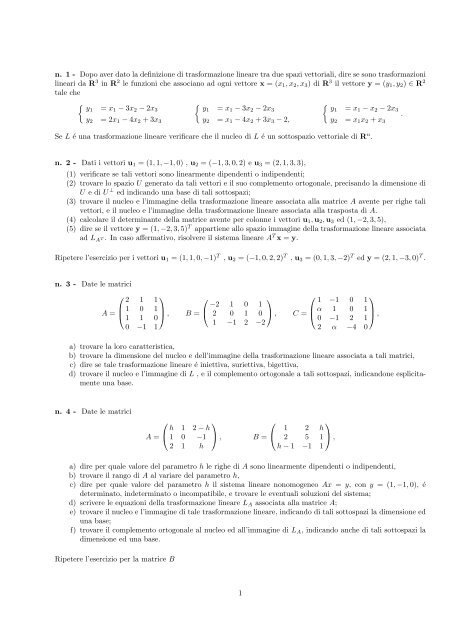
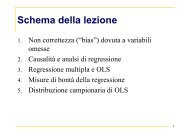
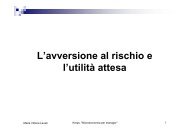


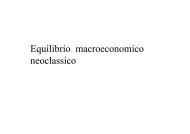

![[ ]](https://img.yumpu.com/14935362/1/184x260/-.jpg?quality=85)
